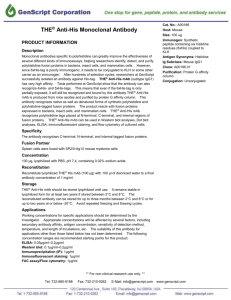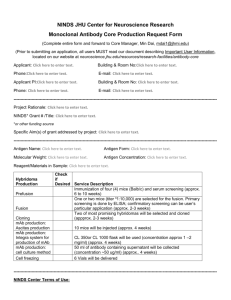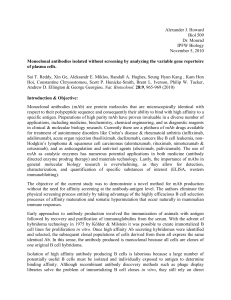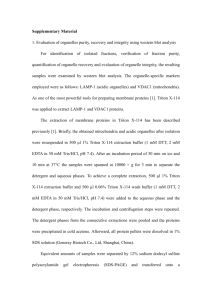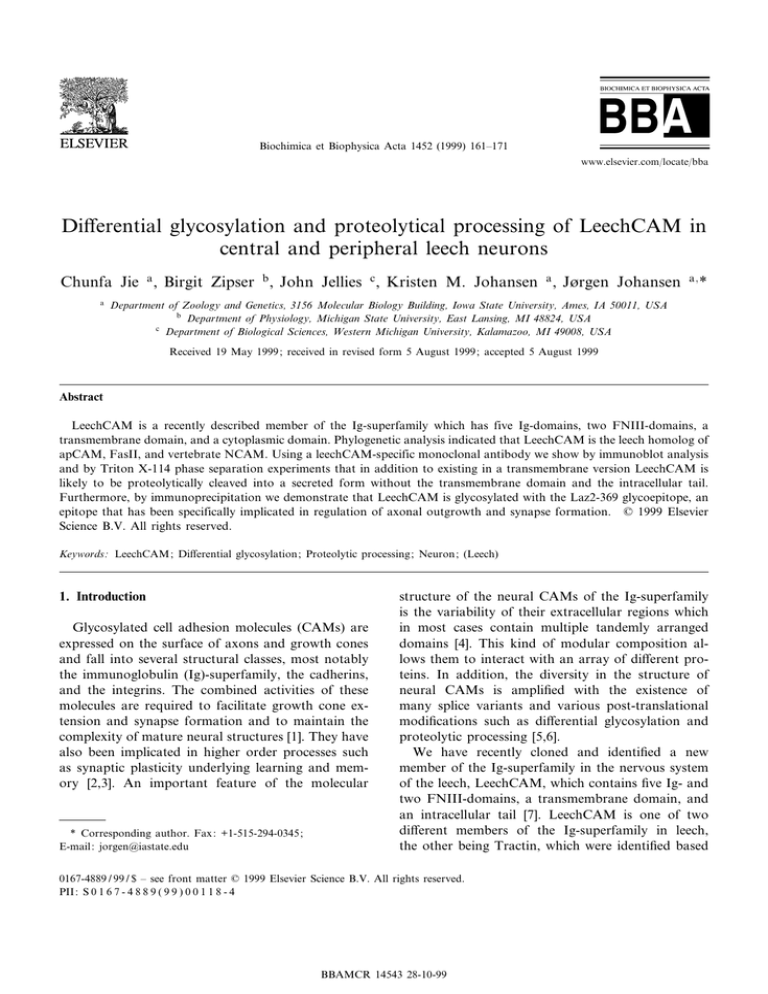
Biochimica et Biophysica Acta 1452 (1999) 161^171
www.elsevier.com/locate/bba
Di¡erential glycosylation and proteolytical processing of LeechCAM in
central and peripheral leech neurons
Chunfa Jie a , Birgit Zipser b , John Jellies c , Kristen M. Johansen a , JÖrgen Johansen
a
a;
*
Department of Zoology and Genetics, 3156 Molecular Biology Building, Iowa State University, Ames, IA 50011, USA
b
Department of Physiology, Michigan State University, East Lansing, MI 48824, USA
c
Department of Biological Sciences, Western Michigan University, Kalamazoo, MI 49008, USA
Received 19 May 1999; received in revised form 5 August 1999; accepted 5 August 1999
Abstract
LeechCAM is a recently described member of the Ig-superfamily which has five Ig-domains, two FNIII-domains, a
transmembrane domain, and a cytoplasmic domain. Phylogenetic analysis indicated that LeechCAM is the leech homolog of
apCAM, FasII, and vertebrate NCAM. Using a leechCAM-specific monoclonal antibody we show by immunoblot analysis
and by Triton X-114 phase separation experiments that in addition to existing in a transmembrane version LeechCAM is
likely to be proteolytically cleaved into a secreted form without the transmembrane domain and the intracellular tail.
Furthermore, by immunoprecipitation we demonstrate that LeechCAM is glycosylated with the Laz2-369 glycoepitope, an
epitope that has been specifically implicated in regulation of axonal outgrowth and synapse formation. ß 1999 Elsevier
Science B.V. All rights reserved.
Keywords: LeechCAM; Di¡erential glycosylation; Proteolytic processing; Neuron; (Leech)
1. Introduction
Glycosylated cell adhesion molecules (CAMs) are
expressed on the surface of axons and growth cones
and fall into several structural classes, most notably
the immunoglobulin (Ig)-superfamily, the cadherins,
and the integrins. The combined activities of these
molecules are required to facilitate growth cone extension and synapse formation and to maintain the
complexity of mature neural structures [1]. They have
also been implicated in higher order processes such
as synaptic plasticity underlying learning and memory [2,3]. An important feature of the molecular
* Corresponding author. Fax: +1-515-294-0345;
E-mail: jorgen@iastate.edu
structure of the neural CAMs of the Ig-superfamily
is the variability of their extracellular regions which
in most cases contain multiple tandemly arranged
domains [4]. This kind of modular composition allows them to interact with an array of di¡erent proteins. In addition, the diversity in the structure of
neural CAMs is ampli¢ed with the existence of
many splice variants and various post-translational
modi¢cations such as di¡erential glycosylation and
proteolytic processing [5,6].
We have recently cloned and identi¢ed a new
member of the Ig-superfamily in the nervous system
of the leech, LeechCAM, which contains ¢ve Ig- and
two FNIII-domains, a transmembrane domain, and
an intracellular tail [7]. LeechCAM is one of two
di¡erent members of the Ig-superfamily in leech,
the other being Tractin, which were identi¢ed based
0167-4889 / 99 / $ ^ see front matter ß 1999 Elsevier Science B.V. All rights reserved.
PII: S 0 1 6 7 - 4 8 8 9 ( 9 9 ) 0 0 1 1 8 - 4
BBAMCR 14543 28-10-99
162
C. Jie et al. / Biochimica et Biophysica Acta 1452 (1999) 161^171
on their expression of the Lan3-2 glycoepitope [7].
Whereas the core protein of LeechCAM is expressed
by all neurons it is di¡erentially glycosylated with the
mAb Lan3-2 and Lan4-2 glycoepitopes only in sets
and subsets of peripheral sensory neurons that form
distinct fascicles in the CNS [7,8]. In addition, at
least four other mAbs (Lan2-3, Laz6-212, Laz2-369,
Laz7-79) which recognize di¡erent glycoepitopes speci¢c to distinct subsets of these neurons have been
identi¢ed [9^12]. Antibody perturbation experiments
have shown that these glycoepitopes are involved in
regulating axon outgrowth and synapse formation in
a way which may be correlated with their relative
temporal expression. For example, the Lan3-2 glycoepitope promotes ¢lopodial extension and synapse
formation at the initial stages of rapid axonal growth
and synaptic target exploration [7,13^15]. In contrast, at the time when synaptogenesis is likely to
occur upregulation of the Laz2-369 glycoepitope
which inhibits ¢lopodial sprouting may function to
promote stable synapse formation [16,17]. Thus,
these ¢ndings suggest that di¡erential glycosylation
of a widely expressed neural CAM can functionally
regulate neuronal outgrowth and synapse formation
of distinct neuronal subpopulations. In this study we
demonstrate that the Laz2-369 glycoepitope, in addition to the previously reported Lan3-2 and Lan4-2
glycoepitopes, also represents di¡erential glycosylation of the LeechCAM protein. Furthermore, we
present evidence that LeechCAM is proteolytically
processed into a secreted as well as a transmembrane
form.
2.2. Antibodies and immunocytochemistry
2. Materials and methods
2.3.1. SDS^PAGE and immunoblotting
Sodium dodecyl sulfate^polyacrylamide gel electrophoresis (SDS^PAGE) was performed according
to standard procedures [19]. Electroblot transfer was
performed as in Towbin et al. [20] with 1Ubu¡er
containing 20% methanol and in most cases including 0.1% SDS. For these experiments we used the
Bio-Rad Mini PROTEAN II system, electroblotting
to 0.2 Wm nitrocellulose, and using anti-mouse HRPconjugated secondary antibody (Bio-Rad) (1:3000)
for visualization of primary antibody diluted
1:2000 in Blotto for immunoblot analysis. The signal
was developed with DAB (0.1 mg/ml) and H2 O2
(0.03%) and enhanced with 0.008% NiCl2 . The im-
2.1. Experimental preparations
For the present experiments we used the two hirudinid leech species Hirudo medicinalis and Haemopis
marmorata. The leeches were either captured in the
wild or purchased from commercial sources. Dissections of nervous tissue and embryos were performed
in leech saline solutions with the following composition (in mM): 110 NaCl, 4 KCl, 2 CaCl2 , 10 glucose,
10 Hepes, pH 7.4. In some cases 8% ethanol was
added and the saline solution cooled to 4³C to inhibit muscle contractions.
Three previously reported mAbs, P6FN (IgG1 ),
4G5 (IgG1 ), and Laz2-369 (IgG3 ) [7,18] in addition
to a P6FN mouse antiserum were used in these studies. P6FN ascites were obtained by injecting four
mice intraperitoneally with antibody producing hybridoma cells. All procedures for monoclonal antibody ascites production were performed by the Iowa
State University Hybridoma Facility.
For immunocytochemistry dissected Hirudo embryos grown at 22^25³C were ¢xed overnight at
4³C in 4% paraformaldehyde in 0.1 M phosphate
bu¡er, pH 7.4. The embryos were incubated overnight at room temperature with diluted P6FN antiserum (1:500) in PBS containing 0.5% Triton X-100
and 0.005% sodium azide, washed in PBS with 0.4%
Triton X-100, and incubated with HRP-conjugated
goat anti-mouse antibody (Bio-Rad, 1:200 dilution).
After washing in PBS the HRP-conjugated antibody
complex was visualized by reaction in DAB (0.03%)
and H2 O2 (0.01%) for 10 min. The ¢nal preparations
were dehydrated in alcohol, cleared in xylene, and
embedded as whole mounts in Depex mountant.
The labeled preparations were photographed on a
Zeiss Axioskop using Ektachrome 64T ¢lm. The color positives were digitized using Adobe Photoshop
and a Nikon Coolscan slide scanner. In Photoshop
the images were converted to black and white and
image-processed before being imported into Freehand (Macromedia) for composition and labeling.
2.3. Biochemical analysis
BBAMCR 14543 28-10-99
C. Jie et al. / Biochimica et Biophysica Acta 1452 (1999) 161^171
munoblots were digitized using the NIH-image software, a cooled high-resolution CCD-camera (Paultek), and a PixelBu¡er framegrabber (Perceptics) or
an Arcus II scanner (AGFA).
2.3.2. Immunoprecipitation
Immunoprecipitations with Laz2-369 antibody
were performed at 4³C. Dissected Haemopis leech
nerve cords were homogenized in extraction bu¡er
(20 mM Tris^HCl, 200 mM NaCl, 1 mM MgCl2 ,
1 mM CaCl2 , 0.2% NP-40, 0.2% Triton X-100 (pH
7.4), containing the protease inhibitors phenylmethylsulfonyl £uoride (PMSF) and Aprotinin from
Sigma) and the homogenate (20 Wl) incubated with
the nonspeci¢c mouse IgG conjugated to protein A
Sepharose matrix for 2 h. The resulting supernatant
was then incubated with Laz2-369 antibody conjugated to protein A Sepharose matrix (10 Wl) overnight. After a brief spin for 20 s at 2000 rpm the
supernatant was discarded and the immunoa¤nity
matrix resuspended and washed three times with
400 Wl of extraction bu¡er for 15 min. The ¢nal pellet
was resuspended in 20 Wl of SDS^PAGE sample
bu¡er and boiled for 5 min before centrifugation
and analysis of the supernatant by SDS^PAGE and
immunoblotting.
2.3.3. Deglycosylation
Enrichment for the LeechCAM protein was
achieved by selecting for the glycoprotein fraction
using a lentil lectin^Sepharose column (Pharmacia).
Dissected nerve cords were homogenized in lentil
lectin-column binding bu¡er (20 mM Tris^HCl, 200
mM NaCl, 2 mM CaCl2 , 0.2% NP-40, 0.2% Triton
X-100, pH 7.4) containing protease inhibitors. This
homogenate was then batch-incubated overnight at
4³C with lentil lectin^Sepharose beads. The beads
were poured into a column, the column washed
with lentil lectin-binding bu¡er, and the bound fraction competed o¡ with two 15 min incubations with
25 mM Tris^HCl, 10% methyl K-D-mannopyranoside, 0.15% SDS, pH 7.4.
The eluted glycoprotein fraction was mixed with
2Ureaction bu¡er containing 100 mM sodium phosphate (pH 7.5) with 12.5 mU of the N-glycosidase
PNGase F according to the manufacturer's protocols
(GLYKO). The deglycosylation was performed with
or without sample denaturation prior to the addition
163
of enzyme. For deglycosylation with sample denaturation, half of the mixture (glycoprotein fraction
+2Ureaction bu¡er) was denatured by 0.005% SDS
and by 2.5 mM L-mercaptoethanol at 100³C
for 5 min and then cooled on ice. NP-40 and glycosidase enzyme were then sequentially added to the
mixture to complete the components of the reaction
samples. The reaction sample mixture was incubated
for 3 h 45 min at 37³C with shaking, and then processed for SDS^PAGE and immunoblotting analysis.
The other half of the mixture (glycoprotein fraction
+2Ureaction bu¡er) was treated identically as a
negative control, except enzyme was replaced by
H2 O. For deglycosylation without sample denaturation by SDS/L-mercaptoethanol, half of the mixture
(the eluted glycoprotein fraction+2Ureaction bu¡er)
was digested by glycosidase enzyme for 24 h at 37³C
with shaking, and then processed for SDS^PAGE
and immunoblot analysis. The other half of the mixture was treated identically as a negative control,
except enzyme was replaced by H2 O. The protease
inhibitors PMSF and Aprotinin were maintained in
the bu¡ers throughout the whole process.
2.3.4. Triton X-114 phase separation
The phase separation of proteins was performed
according to Bordier [21] and Bajt et al. [11]. Haemopis nerve cords were homogenized in TBS (150
mM NaCl, 10 mM Tris^HCl, pH 7.4) containing
1% Triton X-114 (Sigma) and proteinase inhibitors
(PMSF and Aprotinin). Debris was removed by centrifugation at 2000 rpm at 4³C, and 200 Wl of the
resulting supernatant was overlaid onto a cushion
of 6% (w/v) sucrose and 0.06% Triton X-114 in
TBS in a 0.5-ml Eppendorf tube. Phase separation
was then introduced by incubating the samples at
37³C for 3 min. After clouding indicated completion
of the phase separation, the samples were centrifuged
for 10 min at 2000 rpm. The aqueous phase was
transferred to a separate ice cold tube without sucrose cushion and adjusted to the volume of 200 Wl
by adding fresh TBS bu¡er. Subsequently, 2 Wl fresh
Triton X-114 was added to the samples for a ¢nal
concentration of 1% and its dissolution was achieved
by bathing the samples on ice for 10 min and pipetting back and forth occasionally. The 200-Wl samples
with dissolved Triton X-114 were overlaid back to
the lower detergent phase obtained from the previous
BBAMCR 14543 28-10-99
164
C. Jie et al. / Biochimica et Biophysica Acta 1452 (1999) 161^171
Fig. 1. (A) Diagram of the LeechCAM protein. The protein sequence is organized into ¢ve Ig-domains, two FNIII-domains, a transmembrane domain (TM), and a cytoplasmic domain. The putative proteolytic cleavage site between the second FNIII-domain and the
transmembrane domain is indicated by an arrow. The mAb P6FN was made to a LeechCAM peptide sequence located in the second
FNIII-domain as indicated by the black horizontal bar. (B) Immunoblot of Haemopis nerve cord proteins labeled with mAb P6FN.
The migration of molecular mass markers is indicated in kDa. (C) mAb P6FN labels all central and peripheral neurons and their
projections in a Hirudo E12 embryo. Two ganglia (g) as well as the four main nerve tracks (arrowheads) are indicated. Scale
bar = 100 Wm.
centrifugation for two further rounds of phase separation. At the end of the third round of phase separation, the upper aqueous phase was taken to another ice-cold tube without sucrose cushion, and washed
by the addition of Triton X-114 to a ¢nal concentration of 2%. The dissolution of 2% Triton X-114
was followed by induction of phase separation and
centrifugation as before. The resulting detergent
phase from this washing process was discarded and
the washing procedure was repeated once more. At
the end of the second wash, ethanol was added to the
aqueous phase to precipitate proteins with the ¢nal
concentration of ethanol to be 66% [22]. For analysis
of the detergent phase derived from the ¢rst three
BBAMCR 14543 28-10-99
C. Jie et al. / Biochimica et Biophysica Acta 1452 (1999) 161^171
165
rounds of phase separation, the detergent phase was
rinsed twice with 300 Wl of fresh TBS. At the end of
the second rinse, the detergent phase was dissolved in
200 Wl of fresh TBS and 66% ethanol was used to
precipitate proteins after the dissolution on ice. Proteins concentrated from both phases by precipitation
were vacuum dried, boiled in SDS sample bu¡er, and
subjected to SDS^PAGE and immunoblot analysis.
2.4. Phylogenetic analysis
LeechCAM sequence was compared with known
and predicted sequences using the National Center
for Biotechnology Information BLAST e-mail server.
Phylogenetic analysis was performed by ¢rst generating alignments of CAM sequences with the computer
program ClustalW version 1.7. Gaps in the resulting
alignments were removed by deleting residues corresponding to the gaps. Trees were constructed by
maximum parsimony using the PAUP program [23]
version 3.1.1 on a Power Macintosh G3. All trees
were generated by heuristic searches and bootstrap
values in percent of 1000 replications are indicated
on the bootstrap majority rule consensus tree.
3. Results
3.1. LeechCAM is a glycosylated homolog of apCAM
and FasII
Fig. 1A shows a diagram of the domain structure
of LeechCAM. The monoclonal antibody (mAb)
P6FN used in this study was made to a synthetic
peptide from the second FNIII-domain (Fig. 1A).
On immunoblots this antibody recognizes a doublet
of protein bands of approximately 138 kDa and 120
kDa, respectively (Fig. 1B). The di¡erence between
these bands of 18 kDa suggests that LeechCAM may
be proteolytically cleaved proximally to the transmembrane domain, but distally to the second
FNIII-domain and thus that there are two versions
of the LeechCAM protein: one version containing
the intracellular domain and one without it. Immunocytochemically, the mAb P6FN labels the soma
and projections of all central and peripheral neurons
as illustrated in Fig. 1C.
To assess the contribution of glycosylation to the
Fig. 2. LeechCAM is N-glycosylated. Extracts of Haemopis
nerve cord proteins were digested with N-glycosidase F (deglycosylation) or mock digested (control), separated by SDS^
PAGE, and immunoblotted. N-Glycosidase F treatment of both
LeechCAM fragments as detected by mAb P6FN leads to faster
gel migration. The migration of 200, 116, 97, and 66 kDa
markers is indicated.
molecular mass of the LeechCAM protein we deglycosylated lentil lectin-puri¢ed CNS protein homogenate with N-glycosidase F, which cleaves N-linked
glycosylation. The extracellular portion of LeechCAM possesses 10 potential N-glycosylation sites
[7]. For both of the LeechCAM bands detectable
on immunoblots, N-glycosidase F treatment resulted
in faster migration on SDS^PAGE (Fig. 2). Each of
the two bands recognized by mAb P6FN was heavily
glycosylated with an estimated 20^30 kDa of oligosaccharides (Fig. 2).
The domain organization of LeechCAM of ¢ve Igand two FNIII-domains (Fig. 1A) is similar to that
of the NCAM subfamily of CAMs to which it has
sequence homology in the range from 26% to 30%,
which suggests it is evolutionarily related to these
proteins [7]. To further determine the relationship
between LeechCAM and other CAMs we con-
BBAMCR 14543 28-10-99
166
C. Jie et al. / Biochimica et Biophysica Acta 1452 (1999) 161^171
Fig. 3. Phylogenetic relationship of LeechCAM with other CAMs. Consensus maximum parsimony tree derived from an alignment
with all the gaps removed of LeechCAM and members from the most closely related CAMs. The tree is unrooted. The bootstrap
50% majority rule consensus of 1000 maximum parsimony trees is depicted with associated bootstrap support values.
structed phylogenetic trees based on maximum parsimony [23]. Fig. 3 shows an unrooted consensus tree
based on sequences from CAMs that had the highest
sequence identity with LeechCAM in database
searches. The phylogenetic analysis indicates that
LeechCAM is grouped together in a monophyletic
clade with 100% bootstrap support consisting of apCAM and Drosophila and grasshopper FasII. Thus,
LeechCAM is likely to be the leech homolog of these
proteins which have been shown to be directly involved in regulating growth and remodeling of synaptic connections in Drosophila [24^26] as well as in
Aplysia [27^29].
3.2. LeechCAM is processed into both secreted and
transmembrane forms
The labeling by mAb P6FN of two bands on im-
BBAMCR 14543 28-10-99
C. Jie et al. / Biochimica et Biophysica Acta 1452 (1999) 161^171
167
cate that the high band represents a transmembrane
version of LeechCAM whereas the low band indicates a proteolytically cleaved and secreted form of
LeechCAM.
3.3. LeechCAM is glycosylated with the Laz2-369
glycoepitope
We have previously shown that LeechCAM is differentially glycosylated by the Lan3-2 and Lan4-2
glycoepitopes in peripheral sensory neurons but not
in central neurons [7]. However, an additional glycoepitope recognized by the mAb Laz2-369 and found
on 130 kDa proteins was also a candidate to represent an additional glycomodi¢cation of the LeechCAM protein [11,16]. LeechCAM is glycosylated
with the Lan3-2 epitope in all peripheral sensory
Fig. 4. Triton X-114 phase separation of the proteolytically
cleaved LeechCAM fragment. The lower band partitions exclusively to the aqueous phase (lane 3) whereas the higher band is
found entirely in the detergent phase (lane 2). The control lane
(lane 1) shows an immunoblot of the extracted Haemopis nerve
cord proteins before phase separation. The migration of molecular mass markers is indicated in kDa.
munoblots suggested that LeechCAM may be processed into a peripherally membrane attached as well
as into an integral transmembrane form. To further
test this hypothesis we conducted phase separation
experiments of homogenized CNS proteins with Triton X-114. A homogeneous Triton X-114 solution at
0³C segregates into detergent and aqueous phases
after the solution temperature is raised above 20³C.
This phase separation can be used to distinguish
loosely associated membrane proteins, which will
partition into the aqueous phase, from transmembrane proteins which will mainly partition into the
detergent phase [11,21]. As shown on the immunoblots in Fig. 4, the low band as detected by mAb
P6FN is found exclusively in the aqueous phase
whereas the high band partitions entirely into the
detergent phase (Fig. 4). These results strongly indi-
Fig. 5. LeechCAM is glycosylated with the Laz2-369 glycoepitope. Immunoblots of Laz2-369 immunoprecipitated Haemopis
nerve cord proteins. The Laz2-369 immunoprecipitate (Laz2-369
ip) was recognized by both mAb Laz2-369, mAb P6FN, and
the NH2 -terminal fragment of Tractin-speci¢c mAb 4G5. The
position of the 130 kDa molecular mass marker is indicated.
BBAMCR 14543 28-10-99
168
C. Jie et al. / Biochimica et Biophysica Acta 1452 (1999) 161^171
lane 2). In contrast, the Tractin-speci¢c mAb
4G5 recognizes the middle portion of the Laz2-369
immunoprecipitated protein band. This indicates
that the Laz2-369 immunoprecipitate is made up of
both Tractin and LeechCAM proteins and that the
Laz2-369 glycoepitope is present on LeechCAM.
Thus while LeechCAM is present on all neurons
of both the CNS and PNS, only peripheral sensory
neurons are glycosylated with the Lan3-2 glycoepitope and a subset of these peripheral sensory
neurons in addition is glycosylated with the Laz2369 glycoepitope, as illustrated in the diagram in
Fig. 6.
Fig. 6. LeechCAM is di¡erentially glycosylated with the Lan3-2
and Laz2-369 glycoepitopes. LeechCAM is expressed by and is
present on all neurons in the CNS and PNS (A). However, in a
subset of these neurons, the peripheral sensory neurons, LeechCAM is di¡erentially glycosylated with the Lan3-2 glycoepitope
(B). In addition, some of the peripheral sensory neurons are
glycosylated with the Laz2-369 glycoepitope (C). In this model
the Lan3-2 and Laz2-369 glycoepitopes are depicted at di¡erent
glycosylation sites since proteolytic digestion has shown that
the Lan3-2 and Laz2-369 antibodies recognize di¡erent glycopeptide fragments [11].
neurons [7,30] and it has been estimated that a subset
constituting about 45% of these neurons are also
Laz2-369 positive [12]. In contrast to the Lan3-2 epitope, the antibody labeling of which is greatly reduced
by mannose-BSA, the labeling of the Laz2-369 epitope is reduced by galactose-BSA and not by mannose-BSA [16]. Thus, the two glycoepitopes are likely
to have di¡erent oligosaccharide compositions. We
have recently shown that the Laz2-369 glycoepitope
is also present on the secreted NH2 -terminal fragment of the Ig-superfamily member Tractin in leech
[31]. To test whether the Laz2-369 epitope also is
present on LeechCAM, we immunoprecipitated leech
CNS proteins with Laz2-369 antibody coupled to
protein A-Sepharose beads. The Laz2-369 immunoprecipitate was then washed, boiled, separated by
SDS^PAGE and immunoblotted. Fig. 5 (lane 1)
shows that the Laz2-369 immunoprecipitate forms
a broad protein band centered around 130 kDa
and that the LeechCAM-speci¢c mAb P6FN recognizes the top and bottom part of this band (Fig. 5,
4. Discussion
In this study we have used a monoclonal antibody
to characterize the post-translational processing and
glycosylation of the Ig-superfamily member LeechCAM. We show that the mAb P6FN on immunoblots recognizes two fragments of 138 and 120 kDa,
respectively. The high band in phase-partitioning experiments was found in the detergent phase whereas
the low band was found in the aqueous phase. This
suggests that there are two versions of LeechCAM: a
transmembrane version and a secreted version consisting of the ¢ve Ig-domains and the two FNIIIdomains, but without the transmembrane domain
and the intracellular tail. In contrast to its mammalian homolog, NCAM, which is alternatively spliced
from multiple transcripts [32], LeechCAM mRNA
was identi¢ed as a single transcript on Northern
blots [7], indicating that LeechCAM is likely to be
post-translationally processed by proteolytic cleavage.
There is increasing evidence that secreted forms of
integral membrane proteins including CAMs are released by selective post-translational proteolysis from
the cell surface [6,33]. The cleavage generally occurs
close to the extracellular face of the membrane and is
catalyzed by a group of enzymes collectively referred
to as secretases or sheddases. The biological function
of the proteolytic cleavage of transmembrane proteins are still not well characterized and may vary.
In some cases it may be a process for rapidly downregulating the protein from the cell surface; in others
it may be to generate a soluble form of the protein
BBAMCR 14543 28-10-99
C. Jie et al. / Biochimica et Biophysica Acta 1452 (1999) 161^171
that has properties somewhat di¡erent from those of
the membrane bound form [33]. In some cases the
processing may be necessary for biological activity.
For example, in order to generate a functional Notch
receptor in Drosophila the protein is cleaved by the
disintegrin metallo-protease Kuzbanian to form a disul¢de linked heterodimer [34,35]. In leech it has recently been shown that the Ig-superfamily member
Tractin is proteolytically processed at two cleavage
sites, giving rise to a secreted NH2 -terminal fragment
in addition to a secreted homodimer and a transmembrane heterodimer constituted by the remaining fragments [31]. Thus, proteolytic cleavage of
both Tractin and LeechCAM may be a prerequisite
for their proper function in axonal growth regulation.
The most NH2 -terminal fragment of Tractin is glycosylated with the Lan3-2, Lan4-2, and Laz2-369
glycoepitopes [31] and here by performing immunoprecipitation experiments with the Laz2-369 antibody we show that this is also the case for LeechCAM. In vivo and in vitro antibody perturbation of
some of these glycoepitopes have demonstrated that
they can functionally assist in regulating axonal outgrowth. For example, perturbation with Lan3-2 antibody leads to an inhibition of ¢lopodial extension,
truncated fascicle formation, and a decrease in synaptogenesis [7,13,15]. In contrast, perturbation with
Laz2-369 antibody leads to enhanced neurite and
¢lopodial sprouting as well as an increase in synapse
formation [16,17]. Consequently, these ¢ndings suggest the interesting possibility that although Tractin
and LeechCAM have di¡erent protein sequences,
they may have partially overlapping functions due
to their shared glycoepitopes.
It has long been recognized that the structural diversity of cell surface carbohydrates make them ideal
candidates for mediating cell-speci¢c recognition
processes [36^38]. That this is the case has been
most clearly demonstrated by the process of lymphocyte homing, which is mediated by selectins that are
capable of recognizing and binding ligands expressing speci¢c oligosaccharide structures [39,40]. In the
nervous system distinct carbohydrate epitopes such
as that recognized by anti-HRP antibody in insects
and the HNK-1/L2 epitope in vertebrates have been
demonstrated to be widely expressed on glycoproteins [41]. In addition, several carbohydrate epitopes
169
of more restricted expression and distribution have
been identi¢ed. For example, in the vertebrate olfactory system, stage- and position-speci¢c carbohydrate antigens were found to be topographic markers
for selective projection patterns of olfactory axons
[42,43]. A striking example of how the developmental
regulation of glycosylation can a¡ect neural pathway
formation is provided by the modulation of the
polysialic acid content of NCAM in the plexus region of the chick limb bud where its up-regulation
allows the axons to defasciculate into their proper
pathways [44]. Thus, speci¢c carbohydrate structures
on neural proteins are promising candidates for assisting in patterning neural connections during development.
Acknowledgements
We wish to thank Anna Yeung for expert technical
assistance as well as Dr. Paul Kapke at the Iowa
State University Hybridoma Facility for help with
maintaining the monoclonal antibody lines. This
work was supported by NIH Grant NS 28857
(J.Jo.) and by NSF grant 9724064 (J.Je.).
References
[1] F.S. Walsh, P. Doherty, Neural cell adhesion molecules of
the immunoglobulin superfamily : role in axon growth and
guidance, Annu. Rev. Cell Dev. Biol. 13 (1997) 425^456.
[2] K.C. Martin, E.R. Kandel, Cell adhesion molecules, CREB,
and the formation of new synaptic connections, Neuron 17
(1996) 567^570.
[3] D.J. Hagler, Y. Goda, Synaptic adhesion: the building
blocks of memory?, Neuron 20 (1998) 1059^1062.
[4] M. Tessier-Lavigne, C.S. Goodman, The molecular biology
of axon guidance, Science 274 (1996) 1123^1133.
[5] J. Johansen, K.M. Johansen, Molecular mechanisms mediating axon pathway formation, Crit. Rev. Eukaryotic Gene
Expr. 7 (1997) 95^116.
[6] C.P. Blobel, Metalloprotease-disintegrins : links to cell adhesion and cleavage of TNFK and Notch, Cell 90 (1997) 589^
592.
[7] Y. Huang, J. Jellies, K.M. Johansen, J. Johansen, Di¡erential glycosylation of Tractin and LeechCAM, two novel Igsuperfamily members, regulates neurite extension and fascicle formation, J. Cell Biol. 138 (1997) 143^157.
[8] K.M. Johansen, D.M. Kopp, J. Jellies, J. Johansen, Tract
formation and axon fasciculation of molecularly distinct pe-
BBAMCR 14543 28-10-99
170
[9]
[10]
[11]
[12]
[13]
[14]
[15]
[16]
[17]
[18]
[19]
[20]
[21]
[22]
[23]
[24]
C. Jie et al. / Biochimica et Biophysica Acta 1452 (1999) 161^171
ripheral neuron subpopulations during leech embryogenesis,
Neuron 8 (1992) 559^572.
R.D.G. McKay, S. Hock¢eld, J. Johansen, I. Thompson, K.
Frederiksen, Surface molecules identify groups of growing
axons, Science 222 (1983) 788^794.
A. Peinado, E.R. Macagno, B. Zipser, A group of related
surface glycoproteins distinguish sets and subsets of sensory
a¡erents in the leech nervous system, Brain Res. 410 (1987)
335^339.
M.L. Bajt, R.N. Cole, B. Zipser, The speci¢city of the
130-kDa leech sensory a¡erent proteins is encoded by their
carbohydrate epitopes, J. Neurochem. 55 (1990) 2117^
2125.
K. Zipser, M. Erhardt, J. Song, R.N. Cole, B. Zipser, Distribution of carbohydrate epitopes among disjoint subsets of
leech sensory a¡erent neurons, J. Neurosci. 14 (1994) 4481^
4493.
B. Zipser, R. Morell, M.L. Bajt, Defasciculation as a path¢nding strategy: involvement of a speci¢c glycoprotein, Neuron 3 (1989) 621^630.
J. Song, B. Zipser, Kinetics of the inhibition of axonal defasciculation and arborization mediated by carbohydrate
markers in the embryonic leech, Dev. Biol. 168 (1995) 319^
331.
M.-H. Tai, B. Zipser, Mannose-speci¢c recognition mediates
two aspects of synaptic growth of leech sensory a¡erents:
collateral branching and proliferation of synaptic vesicle
clusters, Dev. Biol. 201 (1998) 154^166.
J. Song, B. Zipser, Targeting of neuronal subsets by their
sequentially expressed carbohydrate markers, Neuron 14
(1995) 537^547.
M.-H. Tai, B. Zipser, Sequential steps in synaptic targeting
of sensory a¡erents are mediated by constitutive and developmentally regulated glycosylations of CAMs, Dev. Biol.
(1999) in press.
N. Hogg, M. Flaster, B. Zipser, Cross-reactivities of monoclonal antibodies between select leech neuronal and epithelial
tissues, J. Neurosci. Res. 9 (1983) 445^457.
U.K. Laemmli, Cleavage of structural proteins during assembly of the head of bacteriophage T4, Nature 227 (1970)
680^685.
H. Towbin, T. Staehelin, J. Gordon, Electrophoretic transfer
of proteins from polyacrylamide gels to nitrocellulose sheets:
procedure and some applications, Proc. Natl. Acad. Sci.
USA 76 (1979) 4350^4354.
C. Bordier, Phase separation of integral membrane proteins
in Triton X-114 solution, J. Biol. Chem. 256 (1981) 1604^
1607.
T. Pohl, Concentration of proteins and removal of solutes,
Methods Enzymol. 182 (1990) 68^83.
D.L. Swo¡ord, Phylogenetic analysis using parsimony, Illinois Natural History Survey, Champaign, IL, 1993.
C.M. Schuster, G.W. Davis, R.F. Fetter, C.S. Goodman,
Genetic dissection of structural and functional components
of synaptic plasticity: fasciclin II controls synaptic stabilization and growth, Neuron 17 (1996) 641^654.
[25] C.M. Schuster, G.W. Davis, R.F. Fetter, C.S. Goodman,
Genetic dissection of structural and functional components
of synaptic plasticity: fasciclin II controls structural plasticity, Neuron 17 (1996) 655^667.
[26] G.W. Davis, C.M. Schuster, C.S. Goodman, Genetic analysis of the mechanisms controlling target selection: target-derived fasciclin II regulates the pattern of synapse formation,
Neuron 19 (1997) 561^573.
[27] M. Mayford, A. Barzilai, F. Keller, S. Schacher, E.R. Kandel, Modulation of an NCAM-related adhesion molecule
with long-term synaptic plasticity in Aplysia, Science 256
(1992) 638^644.
[28] H. Zhu, F. Wu, S. Schacher, Aplysia cell adhesion molecules
and serotonin regulate sensory cell-motor cell interactions
during early stages of synapse formation in vitro, J. Neurosci. 14 (1994) 6886^6900.
[29] H. Zhu, F. Wu, S. Schacher, Changes in expression and
distribution of Aplysia cell adhesion molecules can in£uence
synapse formation and elimination in vitro, J. Neurosci. 15
(1995) 4173^4183.
[30] J. Jellies, K.M. Johansen, J. Johansen, Speci¢c pathway selection by the early projections of individual peripheral sensory neurons in the embryonic medicinal leech, J. Neurobiol.
25 (1994) 1187^1199.
[31] C. Jie, B. Zipser, J. Jellies, K.M. Johansen, J. Johansen,
Di¡erential glycosylation and post-translational processing
of Tractin, a novel Ig-superfamily member involved in neuronal outgrowth, Soc. Neurosci. Abstr. 24 (1998) 538.
[32] B.A. Cunningham, J.J. Hemperly, B.A. Murray, E.A. Prediger, R. Brackenbury, G.M. Edelman, Neural cell adhesion
molecule: structure, immunoglobulin-like domains, cell surface modulation, and alternative RNA splicing, Science 236
(1987) 799^806.
[33] N.M. Hooper, E.H. Karran, A.J. Turner, Membrane protein
secretases, Biochem. J. 321 (1997) 265^279.
[34] D. Pan, G.M. Rubin, Kuzbanian controls proteolytic processing of Notch and mediates lateral inhibition during Drosophila and vertebrate neurogenesis, Cell 90 (1997) 271^280.
[35] C.M. Blaumueller, H. Qi, P. Zagouras, S. Artavanis-Tsakonas, Intracellular cleavage of Notch leads to a heterodimeric
receptor on the plasma membrane, Cell 90 (1997) 281^291.
[36] S. Roseman, The synthesis of complex carbohydrates by
multiglycosyltransferase systems and their potential function
in intercellular adhesion, Chem. Phys. Lipids 5 (1971) 270^
297.
[37] H. Lis, N. Sharon, Protein glycosylation: structural and
functional aspects, Euro. J. Biochem. 281 (1993) 1^27.
[38] R.A. Dwek, Glycobiology: `towards understanding the function of sugars', Biochem. Soc. Trans. 23 (1995) 1^25.
[39] T.A. Springer, Tra¤c signals for lymphocyte recirculation
and leukocyte emigration : the multistep paradigm, Cell 76
(1994) 301^314.
[40] L.A. Lasky, Selectin-carbohydrate interactions and the initiation of the in£ammatory response, Annu. Rev. Biochem.
64 (1995) 113^139.
[41] T.M. Jessell, M.A. Hynes, J. Dodd, Carbohydrates and car-
BBAMCR 14543 28-10-99
C. Jie et al. / Biochimica et Biophysica Acta 1452 (1999) 161^171
bohydrate-binding proteins in the nervous system, Annu.
Rev. Neurosci. 13 (1990) 227^255.
[42] B. Key, R.A. Akeson, Delineation of olfactory pathways in
the frog nervous system by unique glycoconjugates and NCAM glycoforms, Neuron 6 (1991) 381^396.
[43] G.A. Schwarting, G. Deutsch, D.M. Gattey, J.E. Crandall,
Glycoconjugates are stage- and position-speci¢c cell surface
171
molecules in the developing olfactory system. II. Unique
carbohydrate antigens are topographic markers for selective
projection patterns of olfactory axons, J. Neurobiol. 23
(1992) 130^142.
[44] U. Rutishauser, L. Landmesser, Polysialic acid in the vertebrate nervous system: a promoter of plasticity in cell-cell
interactions, Trends Neurosci. 19 (1996) 422^427.
BBAMCR 14543 28-10-99




